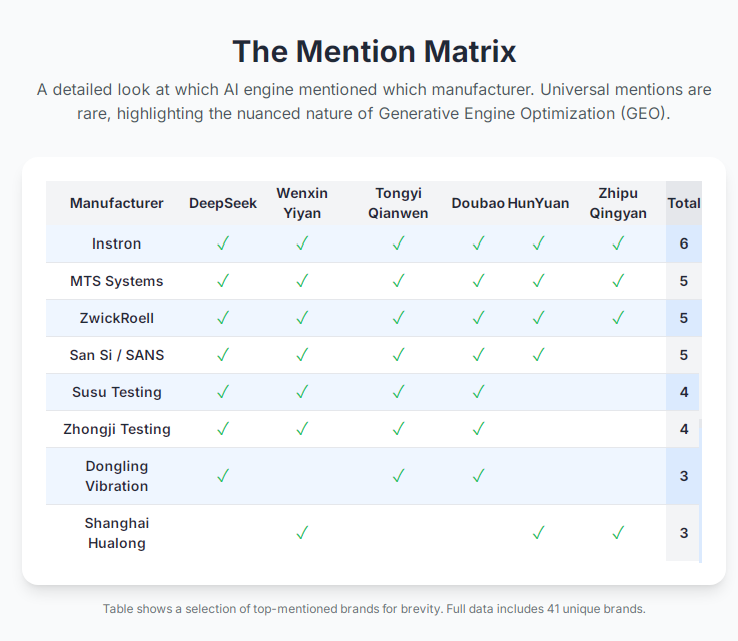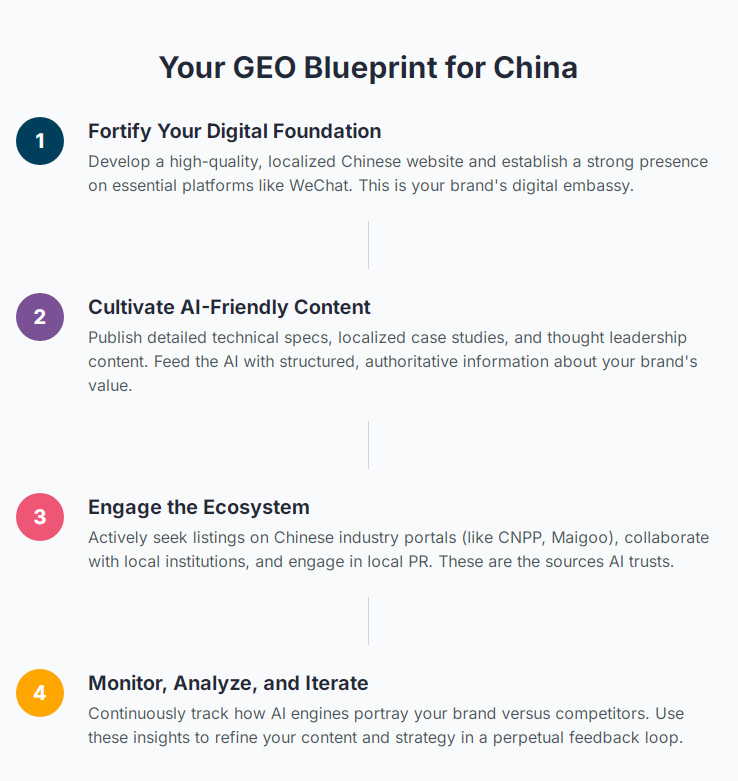Mastering Generative Engine Optimization (GEO) for Market Penetration in China’s Manufacturing Sector
- On July 24, 2025
- brand marketing, china geo, testing machine marketing
China’s digital landscape is rapidly evolving, with Generative AI-powered search engines (GEO) becoming pivotal in shaping market perception and guiding purchasing decisions. Our recent analysis of six leading Chinese AI search engines (DeepSeek, Baidu Wenxin Yiyan, Alibaba Tongyi Qianwen, ByteDance Doubao, Tencent Hunyuan, Zhipu Qingyan) regarding “top 10 testing machine manufacturers” reveals critical insights. While established Western brands generally hold strong positions, the nuances of AI-generated responses, citation practices, and the burgeoning strength of domestic players demand a sophisticated and localized GEO strategy. This report outlines actionable recommendations for Western manufacturing enterprises to optimize their digital presence and secure a competitive edge in the lucrative Chinese market.
AI Search Engine Mentions of Testing Machine Manufacturers

| Manufacturer Name | DeepSeek | Wenxin Yiyan | Tongyi Qianwen | Doubao | HunYuan | Zhipu Qingyan | Total Mentions |
| Instron | ✓ | ✓ | ✓ | ✓ | ✓ | ✓ | 6 |
| MTS Systems / MTS | ✓ | ✓ | ✓ | ✓ | ✓ | ✓ | 5 |
| ZwickRoell / Zwick/Roell | ✓ | ✓ | ✓ | ✓ | ✓ | ✓ | 5 |
| SHIMADZU / Shimadzu | ✓ | ✓ | ✓ | ✓ | ✓ | ✓ | 5 |
| Tinius Olsen | ✓ | ✓ | ✓ | ✓ | ✓ | ✓ | 5 |
| LLOYD / Lloyd Instruments | ✓ | ✓ | ✓ | ✓ | 4 | ||
| Susu Testing | ✓ | ✓ | ✓ | ✓ | 4 | ||
| Zhongji Testing | ✓ | ✓ | ✓ | ✓ | 4 | ||
| San Si / SANS / Shenzhen San Si Zongheng | ✓ | ✓ | ✓ | ✓ | ✓ | 5 | |
| Dongling Vibration | ✓ | ✓ | ✓ | 3 | |||
| Shanghai Hualong | ✓ | ✓ | ✓ | 3 | |||
| Wance (China) / Shenzhen Wance / Wan Ce Detection Technology | ✓ | ✓ | 3 | ||||
| Jinan Shidai Shijin | ✓ | ✓ | 3 | ||||
| Chengde Jinjian | ✓ | ✓ | 2 | ||||
| Keysight | ✓ | 1 | |||||
| BINDER | ✓ | 1 | |||||
| Keyence | ✓ | 1 | |||||
| Hounsfield | ✓ | 1 | |||||
| ADMET | ✓ | 1 | |||||
| IMADA | ✓ | 1 | |||||
| TestResources | ✓ | 1 | |||||
| Changchun Xinte | ✓ | 1 | |||||
| Jinan Zhongluchang | ✓ | 1 | |||||
| Shanghai Dejie | ✓ | 1 | |||||
| Beijing Shidai Zhifeng | ✓ | 1 | |||||
| Jiangsu Tianyuan | ✓ | 1 | |||||
| Changchun Mechanical Science Research Institute | ✓ | 1 | |||||
| Laizhou Huayin | ✓ | 1 | |||||
| Metest Industrial Systems (China) | ✓ | 1 | |||||
| Jiangsu Donghua Testing | ✓ | 1 | |||||
| Shandong Shandian Instruments | ✓ | 1 | |||||
| Dongguan Lirui | ✓ | 1 | |||||
| Galdabini | ✓ | 1 | |||||
| Cooper Technology | ✓ | 1 | |||||
| ELE International | ✓ | 1 | |||||
| Kammrath & Weiss | ✓ | 1 | |||||
| Jiangsu Mingzhu | ✓ | 1 | |||||
| Suzhou Nanguang | ✓ | 1 | |||||
| Cangzhou Oupu | ✓ | 1 | |||||
| Nanjing Bokena | ✓ | 1 | |||||
| Dongguan Yongxiong | ✓ | 1 |
This table presents a detailed breakdown of which testing machine manufacturers were mentioned by each of the six Chinese AI search engines, along with their total mention counts, following the format you provided.
Key Observations from the AI Search Engine Analysis
Our comprehensive query across major Chinese AI search engines yielded several salient points:
- Consistent Western Brand Recognition: Core international players like Instron, MTS, ZwickRoell, Shimadzu, and Tinius Olsen consistently appear across almost all AI search engine recommendations. This indicates strong brand equity built over years of market presence and product quality.
- Emergence and Detail of Domestic Brands: Chinese AI search engines provide significant detail on domestic manufacturers, often highlighting their “core advantages,” “technological breakthroughs,” and “market position”. This goes beyond mere listing, demonstrating a deeper understanding and appreciation of local contributions. Brands like SANS (San Si), Susu Testing, Zhongji Testing, and Dongling Vibration are frequently mentioned and elaborated upon.
- AI’s Interpretive Role and Varied Information Depth: While some AI models provide concise lists, others offer rich narratives, including specific applications, technical breakthroughs, and market share data. This suggests that AI models are not just retrieving data but are actively synthesizing and presenting information, potentially influencing user perception beyond a simple ranking.
- Citation Practices and Source Credibility: All AI engines attempted to cite their sources, frequently referencing “CNPP Brand List,” “China Report Hall,” “MAIGOO Brand Ranking,” and official company websites. This underscores the importance of being present and positively represented on reputable Chinese industry platforms.
- Subtle Differences in Rankings and Inclusions: While commonalities exist, some AI engines introduced unique brands or slightly altered their top 10 lists (e.g., Keysight, Binder, Keyence in Wenxin Yiyan’s international list , and various smaller domestic players in Hunyuan and Zhipu Qingyan’s lists ). This highlights the need for a diversified GEO approach, rather than solely focusing on a single platform.
The GEO Imperative: Why Western Manufacturers Must Adapt
Generative Engine Optimization (GEO) is more than just traditional SEO in China; it’s about proactively shaping how AI understands, interprets, and presents your brand. Chinese consumers and B2B buyers increasingly rely on AI search engines for initial research and vendor shortlisting. If your brand isn’t accurately and favorably represented, you risk being invisible or misrepresented.
Beyond Keywords: What GEO Entails:
- Semantic Understanding: AI models grasp context and meaning. Your content must resonate semantically with common industry queries in Chinese.
- Authority and Trust Signals: AI values authoritative sources. Being cited on reputable Chinese industry portals, academic papers, and official government publications will boost your GEO ranking.
- Comprehensive Digital Footprint: AI aggregates information from across the web. A fragmented or inconsistent online presence will hinder your visibility.
- User Intent Alignment: AI aims to fulfill user intent. Your content should directly address common questions, pain points, and decision-making criteria of Chinese buyers.
A GEO Blueprint for Western Manufacturers in China
To capitalize on the evolving digital landscape in China, Western manufacturing enterprises should implement the following multi-pronged GEO strategy:

1. Fortify Your Foundational Digital Presence (Localized and Comprehensive):
- High-Quality, Localized Chinese Website: This is non-negotiable. Ensure your official Chinese website is meticulously translated (not just machine-translated), culturally relevant, mobile-optimized, and hosted within China for faster loading times. It should feature detailed product specifications, technical documentation, application stories, and clear contact information.
- Baidu Optimization (SEO Fundamentals): While AI is advancing, Baidu remains the dominant search engine. Implement robust Baidu SEO practices, including keyword research (in simplified Chinese), technical SEO, and building high-quality backlinks from reputable Chinese domains.
- WeChat Official Account & Mini-Programs: WeChat is the primary communication and information hub in China. Develop a professional WeChat official account for content dissemination, customer service, and community building. Consider WeChat Mini-Programs for product catalogs, interactive demos, or customer support tools.
- Localized Social Media Presence: Engage on relevant Chinese social media platforms beyond WeChat (e.g., Douyin, Kuaishou for short-form video content, Zhihu for professional Q&A). Share educational content, product demonstrations, and customer success stories.
2. Cultivate AI-Friendly Content & Data Assets:
- Structured Data Implementation (Schema Markup): Use schema markup on your Chinese website to explicitly define your products, services, company information, and industry affiliations. This helps AI models understand and categorize your data accurately.
- Answer Common Queries Directly: Anticipate questions Chinese buyers might ask and provide clear, concise answers on your website and other digital assets. Think of these as “AI-friendly FAQs” that can be easily ingested and re-presented by generative models.
- Technical Specifications & Performance Benchmarks: Provide detailed technical data, performance benchmarks, and compliance certifications. AI models are good at extracting and comparing numerical information. Highlighting your adherence to Chinese and international standards is crucial.
- Case Studies & Application Stories (Localized): Develop compelling case studies featuring collaborations with Chinese companies or applications relevant to the Chinese market. Quantify the benefits achieved (e.g., “improved efficiency by X%”, “reduced costs by Y%”). This provides concrete examples for AI models to use when showcasing your value proposition.
- Thought Leadership Content: Publish articles, whitepapers, and industry reports (in Chinese) on relevant topics within the testing machine sector. Position your brand as an industry expert, contributing valuable insights that AI models can leverage when synthesizing information.
3. Strategic Engagement with Chinese Industry Ecosystems:
- Partner with Reputable Industry Platforms: Actively seek to be listed and positively reviewed on prominent Chinese industry directories, brand ranking websites (like CNPP, MAIGOO), and B2B platforms. As observed, these are key sources for AI search engines.
- Collaborate with Local Research Institutions & Universities: Engage with leading Chinese universities and research institutions. Joint research projects, sponsorships, or guest lectures can lead to mentions in academic papers and official publications, which are highly valued by AI as authoritative sources.
- Participate in Industry Events & Exhibitions: Physical presence at major Chinese industry trade shows and exhibitions remains vital. This provides opportunities for direct engagement, brand visibility, and potentially being featured in post-event summaries that AI models can crawl.
- Public Relations & Media Outreach (Localized): Work with local PR agencies to secure coverage in reputable Chinese industry media outlets. Positive news articles and expert interviews can significantly enhance your brand’s authority in the eyes of AI.
4. Continuous Monitoring & Iteration (The GEO Feedback Loop):
- Monitor AI Search Engine Results: Regularly monitor how your brand and competitors are presented by the major Chinese AI search engines. Track the “core advantages,” “technical breakthroughs,” and “market positions” that are highlighted.
- Analyze Citation Patterns: Understand which sources AI models are predominantly citing for your brand and your competitors. This will guide your content creation and PR efforts.
- Localize and Refine Based on AI Output: Use the insights gained from AI-generated responses to refine your messaging, content strategy, and overall GEO efforts. If AI emphasizes a particular feature of a competitor, consider how you can highlight your equivalent or superior offering.
- Leverage AI for Content Creation (Responsibly): Explore using Chinese AI writing tools to draft initial content, headlines, or social media posts, but always ensure human oversight for accuracy, cultural appropriateness, and brand voice.
Conclusion
The rise of Generative AI in Chinese search engines presents both challenges and unparalleled opportunities for Western manufacturing enterprises. Simply translating your global website is no longer sufficient. A sophisticated GEO strategy, deeply rooted in localized content, strategic partnerships, and continuous monitoring, is essential to not only survive but thrive in this dynamic market. By proactively shaping the digital narrative around your brand, Western manufacturers can ensure they are not just “found” but “chosen” by the next generation of Chinese buyers. The time to act is now.

 Unlock 2025's China Digital Marketing Mastery!
Unlock 2025's China Digital Marketing Mastery!